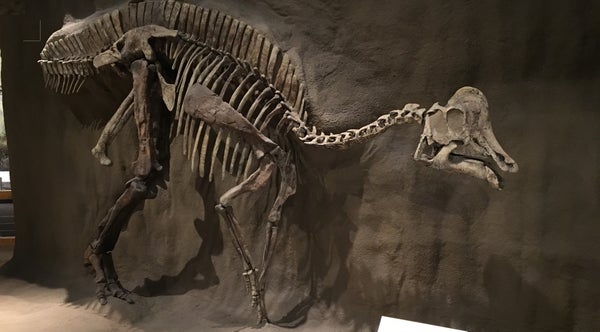This article was published in Scientific American’s former blog network and reflects the views of the author, not necessarily those of Scientific American
One of the things every dinosaur fan learns early on is how to categorize a “terrible lizard” by its hips.
All dinosaurs fall into one of two major groups that have traditionally been defined by hip shape. There are the saurischian - or “lizard-hipped” - dinosaurs where a paired bone called the pubis is typically swept forward, and then there are the “bird-hipped” ornithischians where the pubis juts backwards to join another bone called the ischium.
Now, this can get a little confusing. Ornithischian dinosaurs aren’t closely related to birds at all. Birds, which do show a similar hip anatomy, are actually saurischian dinosaurs that independently evolved a convergent hip shape. And there’s been some recent debate about whether these categories should still be used at all. But the thing to remember is that dinosaurs typically exhibit one of these two hip layouts, with the pubic bones pointing forwards, backwards, or occasionally in-between. Why the difference? Paleontologists Loredana Macaluso and Emanuel Tschopp address the question in a paper published earlier this year.
On supporting science journalism
If you're enjoying this article, consider supporting our award-winning journalism by subscribing. By purchasing a subscription you are helping to ensure the future of impactful stories about the discoveries and ideas shaping our world today.
Among dinosaurs, the pubic bone shifted to a backwards-pointing position four times among maniraptoran dinosaurs - the group that contains favorites like Velociraptor as well as birds - and once among ornithischians. This might have been due to similar changes in the way the hips are involved with respiration, according to previous analyses, or perhaps could have been driven by requirements for more gut space as dinosaurs evolved herbivorous diets. Macaluso and Tschopp investigated these possibilities by tracking how hip shape, diet, and inferred modes of ventilation might be related to each other.
As it turns out, the change in hip shape doesn’t seem to be tied to munching on plants. The pubic bones weren’t shifting backwards to make room for more guts to break down leafy foods, which makes sense given that the earliest ornithischian dinosaurs already have their characteristic hip shape but have been interpreted as omnivores. (Sauropod dinosaurs, Macaluso and Tschopp note, are a good test of this, too, as they were wholly herbivorous but retained the ancestral, pubis-forward hip shape.) Instead, it seems that changes to the ways that dinosaurs breathed was more important.
The key factor here, the paleontologists write, might be a muscle called the M.ischiotruncus. This muscle connected the ischium to the gastralia - or “belly ribs” - of the dinosaurs who possessed them, pulling these bones backward to expand the abdomen. The pubis, in this scheme, was involved in the setup as a pulley and would have been required to point forward or in an in-between position. But if ornithischian dinosaurs and some maniraptoran dinosaurs started to evolve different ways of ventilating their lungs and associated organs, then the pubic bones could be anatomically freed-up to rotate into a different position. Macaluso and Tschopp note that reproductive factors like egg laying or nesting might have had something to do with more directly driving this change, but, overall, it would seem that changes in how dinosaurs ventilated their lungs allowed for the shift to happen.
What this means, Macaluso and Tschopp note, is that the way ancestral dinosaurs ventilated their lungs was an evolutionary constraint on hip shape. The interlocking anatomical apparatus of soft tissues related to breathing had to change before hip shape could, although the direct drivers of why freed-up pubic bones should change orientation are not yet known. The reasons may even vary from group to group. During the evolution of the first birds, for example, changes in muscular attachments to the hips related to respiration may have also provided unexpected advantages in control over tail motions critical to control during flight.
This goes beyond hip shape, though. If the orientation of the pubic bones really was constrained by the way dinosaurs breathed, then how and why did the earliest ornithischian dinosaurs shift away from the ancestral condition? Paleontologists already knew they were different - lacking the networks of accessory air sacs found throughout the saurischian family tree - but this anatomical difference has never been fully explained. Ornithischian dinosaurs may have been doing something weird, which seems to have been accidentally stumbled upon four different times among maniraptoran dinosaurs. As familiar as dinosaurs may sometimes feel to us, there's still a great deal we don't yet know about their lives.
